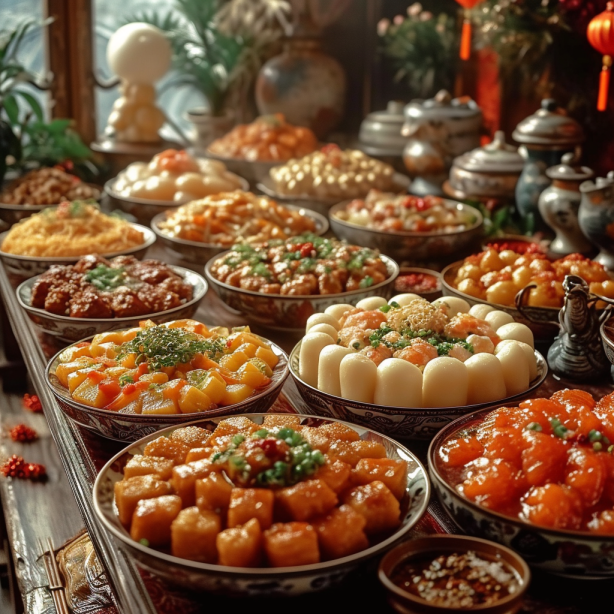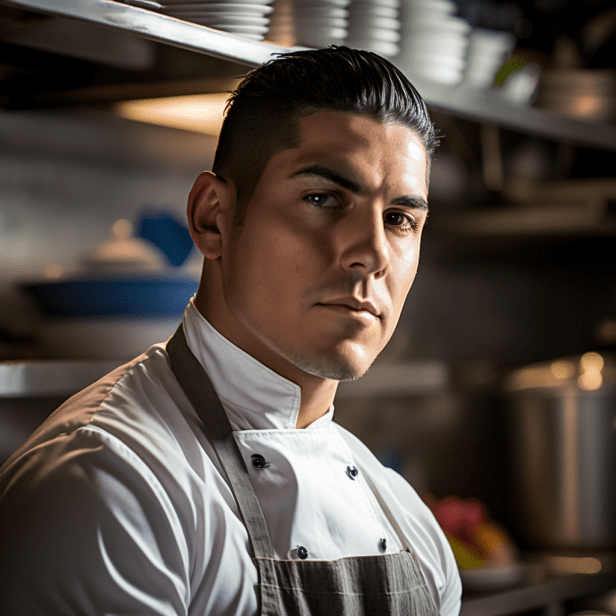Dietitian Jane says, “Authentic Chinese lacks wheat and gluten.
However, Americanized Chinese uses wheat products.”
She advises asking about ingredients if gluten is a concern
As someone avoiding gluten, I’ve learned real Chinese food is gluten-free.
But American Chinese restaurants often add wheat without realizing it!
The savory smells from the Chinese restaurant nearby make my mouth water.
Having celiac disease means being extra careful.
Chinese food can be safe when I stick to plain meat and veggies.
With a few easy swaps, I can still enjoy the bright flavors of Chinese cuisine without getting sick.
How do you navigate Chinese restaurants with food sensitivities? A few simple tricks can help you feast worry-free!
KEY TAKEAWAY
Is there wheat in Chinese food?
Some traditional Chinese dishes may contain wheat, making it essential to inquire about ingredients.
Is wheat commonly used in Chinese cuisine?
Source: Kwoklyn Wan
Wheat has been part of Chinese cooking for thousands of years, but its popularity varies depending on the region.
Originally from Central Asia, wheat started being grown widely in Northern China over 1700 years ago.
Today, it plays a much bigger role in Northern-style Chinese dishes than Southern cooking.
Some Classic Chinese fare like dumplings, noodles, and steamed buns almost always contain wheat flour.
Many families in Northern areas like Beijing and Shanghai have wheat nearly every day.
They enjoy wheaten noodles slurped down with soup or fried into lo mein dishes.
Steamed buns stuffed with fillings are also very common there.
In comparison, Southern Chinese cuisine of places like Yunnan and Guangdong relies more on rice.
Wheat takes a backseat to other grains in many meals. (1)
What dishes commonly contain wheat?

While Chinese food comes in endless variety, some time-honored dishes are very likely to contain wheat. (2)
- NOODLES – Wheat reigns supreme in noodle land. Popular varieties like chow mein, lamian, and biangbiang are hard to find without wheat flour.
- DUMPLINGS – The wrappers enclosing potstickers, baozi, and shumai are typically made from wheat dough for that chewy texture.
- STEAMED BUNS – Light and airy buns called mantou, baozi, and bing would fall flat without wheat in the fluffy dough.
- FRIED SNACKS – Crispy morning foods like you tiao, jianbing, and shaobing satisfy snacks cravings but use wheat to stay together during cooking.
Always check ingredients if avoiding gluten, as wheat makes many Chinese dishes hearty and delicious.
With some effort though, people with gluten issues can still enjoy Chinese cuisine.
What dishes are naturally wheat-free?

While many classic Chinese foods contain wheat, there are still lots of delicious dishes…
… that are naturally GLUTEN-FREE.
These tend to be preparations focusing more on fresh ingredients than flour.
- STIR FRIES like kung pao chicken are quick and can be made with any protein and vegetables. I like to use chicken or tofu with peppers and ROASTED peanuts in a savory sauce.
- SOUPS such as hot and sour or wonton let the distinct flavors of mushrooms, tomatoes, vinegar or shrimp shine without wheat. Filling wonton wrappers with RICE FLOUR makes them gluten-free too.
- STEAMED DISHES bring out veggies’ sweetness through gentle steaming rather than cooking methods using wheat. Fish, shrimp and greens are often served this way with only salt and pepper seasonings.
- RICE DISHES like fried rice and congee rely on SHORT-GRAIN RICE and other grains instead of wheat. These make satisfying one-bowl meals.
By understanding which traditional preparations avoid wheat naturally and which…
… SAUCES like tamari or hoisin are GLUTEN-FREE, everybody can still enjoy Chinese cuisine.
With some simple swaps or selections, those managing celiac or gluten sensitivities need not miss out!
Tips for gluten-free dining
Eating out GLUTEN-FREE takes some savvy when visiting ASIAN RESTAURANTS.
Here are my tried and TRUE tips:
- ASK servers about sauce ingredients like soy sauce or oyster sauce which may contain WHEAT. Some places offer GLUTEN-FREE options.
- AVOID anything with flour coatings like EGG ROLLS which could cause problems. Opt for steaming over frying.
- BE WARY of shared frying oil that cooked wheat-containing food, as it may harbor GLUTEN residues.
- REQUEST that sauces be served on the SIDE rather than mixed into WHOLE dishes or over WHITE RICE. This prevents cross-contact.
- EXPLAIN your dietary need is not a preference but a medical requirement like CELIAC DISEASE. Servers may not otherwise realize risks of gluten exposure.
With assertive explanations, restaurants can typically find GLUTEN-FREE SUBSTITUTIONS…
… for soy sauce with tamari or coconut aminos.
And choose from naturally wheat-free dishes.
With some knowledge, an ASIAN feast is still quite possible and delicious.
Gluten-free substitutes for Chinese meals

Making traditional Chinese dishes GLUTEN-FREE takes some basic SWAPS.
Instead of wheat noodles, try varieties made from RICE or MUNG BEAN FLOUR…
… which are just as slurpable in soups and STIR FRIES.
Look for RICE WRAPPERS as an alternative to regular dumpling wrappers too.
TAMARI soy sauce substitutes well for its SWEET AND SOUR FLAVOR…
… where traditional varieties contain wheat.
Some brands even label their tamari GLUTEN-SENSITIVE.
Just be sure to check labels.
It’s also EASY to find GLUTEN-FREE options for CHINESE takeout classics.
Many restaurants now offer BROWN RICE instead of fried noodles…
… and the ability to hold wheat-based sauces.
With creative adjustments, the whole family can still enjoy Chinese together.
Make your own gluten-free Chinese meals at home
Cooking Chinese food at home allows FULL CONTROL over ingredients for those avoiding GLUTEN.
Popular recipes like MAPO TOFU with silky tofu in a spicy sauce and…
… KUNG PAO CAULIFLOWER with tender veggies are incredibly EASY and satisfying.
Always use CERTIFIED GLUTEN-FREE ingredients and sauces when in the kitchen.
READ LABELS carefully since some may contain hidden sources of wheat.
I particularly enjoy adding fresh BOK CHOY, shiitake mushrooms…
… and chicken to complement the main dishes.
For those with GLUTEN SENSITIVITY, it’s vital to maintain a DEDICATED GLUTEN-FREE preparation area.
This means washing surfaces before and after with hot, soapy water to REMOVE any particles.
Space is ideally separated from areas touched by regular wheat items.
Homemade Chinese allows eating GLUTEN-FREE versions of cuisine we all enjoy.
With some basic cooking knowledge and small adjustments, those avoiding…
… GLUTEN need not settle for lackluster options elsewhere ever again.
Additional considerations for those with gluten issues

Eating out with GLUTEN allergies takes extra STEPS.
First, AVOID shared equipment in restaurants that could become cross-contaminated like fryers.
Secondly, TALK to staff about dietary needs to prevent any MIX-UPS.
Some OTHER tips:
- Ask if sauces or dishes could contain hidden WHEAT sources like SOY SAUCE, POTATO or TAPIOCA starch. TAMARI is generally safer.
- Be leery of dishes with beer, WHEAT NOODLES or soy sauce reductions that may contain GLUTEN despite removal. Rice noodles substitute well.
- If unsure, opt for simply cooked meat and vegetables rather than pre-made dishes which pose higher risk.
- Always CARRY safe snacks just in case there are no GLUTEN-FREE options available on-site. Rice crackers or nuts provide backup sustenance.
Following these steps allows finding tasty ASIAN CUISINE choices…
…without risking a reaction, even when dining out on the go.
With some forethought, people with CELIAC or gluten issues can still enjoy the whole experience.
Frequently Asked Questions
Are most Chinese foods gluten free?
While many traditional Chinese foods like white rice, spring rolls, and…
… steamed vegetables are naturally gluten free, it can be pretty easy to…
… accidentally eat gluten when ordering Chinese food.
Some sauces and dishes may contain unexpected wheat ingredients.
What sauces commonly contain gluten?
A few dark sauces like hoisin sauce, oyster sauce, and traditional soy sauce often contain wheat.
Make sure to check the labels or ask if the sauce is gluten free.
Most restaurants now have gluten free soy sauce options.
Are rice noodles gluten free?
Yes, rice noodles which are also called rice noodle or lo mein, are always gluten free…
… since they are made from rice flour instead of wheat flour.
They are a delicious gluten free alternative to regular wheat noodles.
How can I avoid cross contamination when eating out?
Be sure to tell your server that you have a gluten free diet and ask them to avoid…
… cross contamination in the cooking process.
Many Chinese restaurants now have separate fryers or designated…
… gluten free areas in the kitchen to prepare food without traces of gluten.
What substitutes can I use for gluten containing ingredients?
When cooking Chinese food at home, you can use tapioca starch, potato starch or…
… a blend of both instead of wheat gluten in recipes for things like dumplings or chow mein.
Rice flour is also a great substitute for wheat flour in things like spring rolls or egg rolls.
Are Chinese takeout and delivery typically gluten free friendly?
Most chain Chinese restaurants now offer gluten free menu options and clearly label what is gluten free.
You can also find many gluten free Chinese food recipes online to make…
… your favorite dishes at home using gluten free ingredients.
Just be sure to confirm with the restaurant about their policies on cross-contamination from frying.
What are some naturally gluten free Chinese dishes?
Dishes like steamed or stir-fried vegetables, plain white rice, pork and chicken…
… that is baked, broiled or sautéed rather than breaded or battered are naturally gluten free.
Other options include orange chicken, sweet and sour chicken, kung pao chicken,…
…mongolian beef, cashew chicken, pepper steak and beef and broccoli.
Just be careful of sauce ingredients.
Conclusion
When it comes to Chinese food, those avoiding gluten need to be careful.
While authentic Chinese dishes are naturally gluten-free, Americanized Chinese restaurants…
… often add wheat-based ingredients like thickening agents or soy sauce without realizing it.
As someone who avoids gluten due to celiac disease, I’ve learned to ALWAYS…
… verify ingredients by asking the restaurant directly if wheat or gluten is present.
Many times, simple substitutions or removal of thickening agents like cornstarch can make a dish gluten-free.
The KEY is knowing what to look for and advocating for your needs.
With some preparation and research, you can enjoy the vibrant flavors…
…of Chinese cuisine without the agony of gluten exposure.
Pay attention to menu items like steamed or stir-fried meats…
… and vegetables, avoid breaded items and thick sauces, and don’t be afraid to make special requests.
At the end of the day, cross-contamination is also possible in restaurants, so…
… your level of caution depends on your sensitivity.
But overall, YES you can eat Chinese food without wheat or gluten with some simple adjustments.
The takeaway? Be informed, be your own advocate, and enjoy the food!
References
- https://www.nationalgeographic.com/culture/article/wheat–not-rice-grows-here
- https://blackbird-bakery.com/gluten-free-chinese-food/
Related Articles
- https://bowlakechinese.com/is-there-any-chinese-food-that-is-gluten-free/
- https://bowlakechinese.com/what-chinese-foods-are-gluten-free/
- https://bowlakechinese.com/gluten-free-chinese-ingredients-2/
Was this helpful?

I am a skilled chef assistant with a passion for Asian cuisine, I have honed my craft through formal training at At-Sunrice GlobalChef Academy and years of experience in the culinary industry. I have extensive knowledge of cooking techniques and herbs and spices, with a particular focus on traditional Chinese dishes. I’m also an author of the book “Delicious Keto Low Carb Chinese Food for Busy Moms and Fitness Enthusiasts” which is sold on Amazon. On my blog, bowlakechinese.com, I share my expertise in Asian cuisine and provide tips and recipes for those interested in low carb Chinese cuisine.

